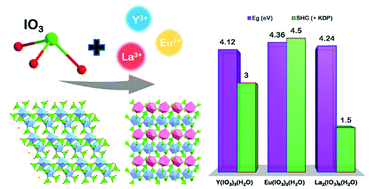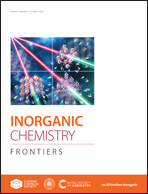Incorporating rare-earth cations with moderate electropositivity into iodates for the optimized second-order nonlinear optical performance†
Abstract
Infrared (IR) nonlinear optical (NLO) materials have attracted tremendous interest for civil and military applications, but it remains a great contemporary challenge to develop high-efficiency NLO crystals that possess sufficiently high second-harmonic generation (SHG) efficiencies coupled to wide transparency ranges and high laser damage thresholds. A series of new hydrous rare-earth iodates RE(IO3)3·(H2O) (RE = Y 1, Eu 2) and La2(IO3)6(H2O) (3) have been synthesized through facile hydrothermal methods. 1 and 2 are isostructural, crystallizing in the polar space group P21, while 3 crystallizes in the polar space group Pc. 1–3 feature three-dimensional (3D) frameworks composed of alternately connected corner-shared distorted [REOx] polyhedra (RE = Y, Eu, and La; x = 8, 9) and [IO3]− groups. Optical studies showed that 1–3 exhibit good NLO properties, including strong SHG intensities (3.0 × (1), 4.5 × (2), and 1.5 × KH2PO4 (3)), large band gaps (4.12 (1), 4.36 (2), and 4.24 eV (3), with 2 possessing the largest band gap among the known SHG-active rare-earth-based iodates, high laser damage thresholds (LDT) (53 × (1), 43 × (2), and 44 × AgGaS2 (3)), and wide transparency ranges (ca. 3.0–11.3 μm) in the mid-IR region covering two critical IR transparency windows; 1–3 are therefore potential candidate NLO materials. Density functional theory calculations on 1–3 confirm that their strong SHG responses and large band gaps are mainly derived from the synergistic effect of [IO3]− groups and rare-earth oxide polyhedra [REOx] in their 3D frameworks. We conclude that the introduction of rare-earth cations with moderate electropositivity into iodates may optimize the balance between SHG efficiency and optical band gaps, the key requirement for high-performance NLO materials for practical applications.



 Please wait while we load your content...
Please wait while we load your content...